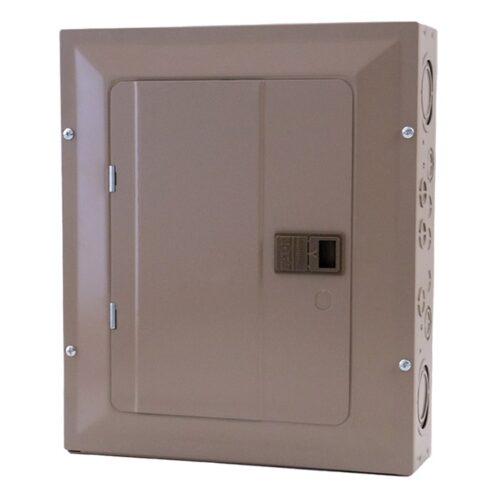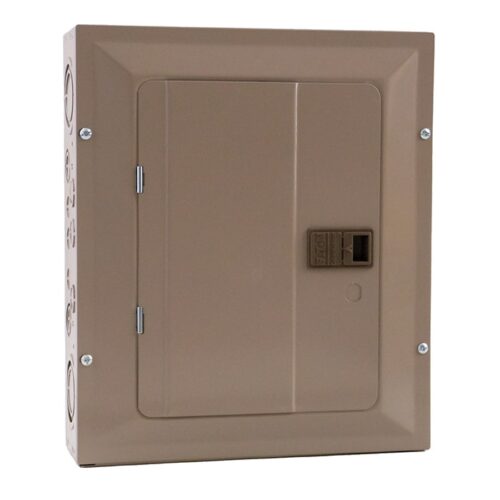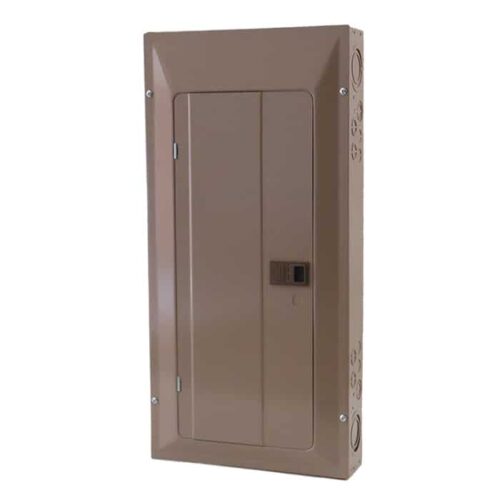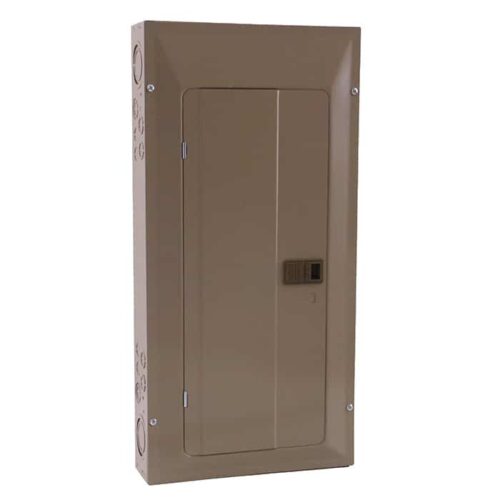A load center is an electrical distribution board that houses circuit breakers or fuses. It ensures power is distributed correctly to various parts of your property while providing a vital safety mechanism in case of electrical faults. At North America Phase Converter, we understand the value of reliable electrical infrastructure. That’s why we offer various types of 3-phase load centers designed to meet the highest standards, providing exceptional performance and safety for residential, commercial and phase conversion applications. Explore our collection of electrical load centers today and experience top-tier performance and safety backed by expert support from our dedicated team.
Types of Electrical Load Centers We Offer
At North America Phase Converter, we provide the following types of 3-phase load centers to meet different electrical distribution needs. Our offerings include:
- Main breaker load centers: A main breaker load center features a main breaker that works as a primary disconnect for all the circuits in the load center. This breaker serves as a safeguard for the entire electrical system by providing overcurrent protection and a way to shut off power to the entire load center at once. This is specifically useful for maintenance or emergencies.
-
- The main breaker offers immediate disconnect for all circuits.
- This safeguards the entire electrical system by preventing overloading or short circuits.
- It is convenient to shut off all power to a building or section with one switch.
- Fusible main load centers: A fusible main load center uses fuses instead of circuit breakers for overcurrent protection. Fuses just blow or disconnect the circuit when an overload or short circuit occurs. In this load center, the main fuse protects the entire system, and each individual branch circuit may also have its own fuse.
- Fuses provide faster response times than circuit breakers, protecting the system more quickly.
- These electrical load centers are easy to install and maintain, particularly in environments where fuses are more commonly used.
- A blown fuse indicates a problem, making it clear when and where a fault has occurred.
- Main lug load centers: A Main Lug Load Center is a bit different from the other two types. This load center does not include a main breaker or fuse; instead, it only features main lugs, which are the points where incoming electrical power is connected to the system. A main disconnect switch, which is located separately, is needed to shut off the entire power supply in this setup.
- Main lug load centers are more affordable than other types.
- These are ideal for systems where a main disconnect is located elsewhere or for subpanel applications.
- Without the need for a main breaker, these load centers are often more compact and are easy to install in tight spaces.
- Recommended and stocked by North America Phase Converter Co. to use in conjunction with a rotary and digital phase converter.
Features of Our Load Center Panels
Our load center panels stand out due to the following reasons:
- Durable construction: Made and constructed with premium-grade materials so you can ensure there durability and ability to withstand tough environmental conditions. They provide superior resistance to wear and corrosion, guaranteeing dependable service even in high-demand environments.
- High-capacity options: We offer load centers in a range of capacities to meet diverse needs. Our panels come in sizes from compact models with 12 spaces, ideal for smaller residential setups, to larger 42-space models suitable for heavy-duty commercial and industrial applications.
- Efficient power distribution: Our load centers provide efficient and organized power distribution. This layout simplifies wiring and circuit management. Whether you are powering a home, office, or industrial facility, our panels ensure an even and safe distribution of electrical power to various circuits.
- Easy installation: Installation is straightforward with our load center panels. They have features like well-labeled compartments and clearly marked wiring areas that minimize the installation time and make wiring and connections easier for electrical professionals.
- Customizable options: We also offer customization options for our load center panels. Whether it is adding more breaker spaces, changing configurations, or selecting specific power ratings, we provide tailored solutions to fit your exact needs.
- Space-saving design: Our load center panels are designed to be compact and efficient in their use of space. Their space-saving design allows easy fitment in various installations, whether you are working in a confined residential area or a larger industrial setup.
Benefits of Using Our Load Centers
Whether for residential, commercial, or industrial applications, here are the key advantages of using our load centers:
- Enhanced safety: When it comes to electrical systems, safety is our top priority. Our load centers are built with multiple safety features to protect both your equipment and personnel. Each panel includes advanced overcurrent protection, which helps prevent electrical overloads and short circuits.
- Reliable performance: Our load centers offer consistent and reliable performance. With high-quality materials and superior craftsmanship, you can trust that your electrical system will function efficiently without unexpected failures.
- Cost-effective solution: Our load centers offer an affordable way to manage and distribute electrical power while maintaining high safety and efficiency standards. By choosing our high-quality panel, you can avoid frequent replacements or costly repairs, making it a wise investment for any electrical system.
- Different options to choose from: We offer various load centers to meet different needs, including Main Breaker Load Centers, Fusible Main Load Centers, and Main Lug Load Centers. This flexibility allows you to choose the right type based on your specific requirements.
By partnering with North America Phase Converter, you are choosing load centers that deliver top-notch safety, reliability, and performance, backed by our commitment to quality.
Applications of Load Centers
Below are some of the key applications where our load centers are commonly used:
- Residential applications: In homes, load centers ensure that power is efficiently distributed while offering overcurrent protection to safeguard against electrical faults.
- Industrial applications: Our load centers are used in industrial facilities to manage the complex electrical systems that power heavy machinery, equipment, and production lines.
- Subpanel applications: Load centers are often used in subpanel configurations, where they serve to extend electrical power from a main panel to specific areas or sub-zones within a building or facility.
- Data centers: Load centers in data centers help manage power while protecting sensitive equipment from electrical faults or overloads.
- Construction sites: On construction sites, our load centers are often used to distribute power to temporary electrical setups, providing safe connections for tools, lights, and equipment.
- Commercial applications: In commercial settings, load centers are used to manage electrical power distribution across offices, retail spaces, and more.
- Renewable energy: In these systems, load centers manage the distribution of electricity generated by renewable sources to various parts of the home or facility.
- Phase conversion: The perfect way to protect multiple loads running after a rotary or digital phase converter.
Tips to Choose the Right Load Center for Your Needs
Here are some important tips that will help you select the best electrical distribution board for your residential, commercial, or industrial applications:
- Specify your electrical load requirements: Before selecting a load center, always specify the total electrical load your system needs to handle and your input voltage. Assess the number of circuits you will require and the electrical demand of each.
- Consider future expansion needs: When selecting a load center, always consider your future electrical needs. Choose a load center with extra space for additional breakers to accommodate potential future upgrades without needing to replace the entire load distribution panel.
- Installation and maintenances considerations: Consider the ease of installation and future maintenance when choosing a load center. Look for features that make the load center easy to wire.
- Customization options: Look for options that allow you to customize the number of circuit spaces, breaker types, or amperage to match your exact needs.
Choosing the right load center is crucial for the safety and efficiency of your electrical system. Whether you need a 3-phase load center for outdoor installation or an indoor load center, our selection features high-quality solutions that ensure efficient and safe electrical distribution. Explore our selection of 3-phase load centers and electrical panel boxes for sale today!
Frequently Asked Questions
Can I use a fusible load center in place of a breaker-based system?
Yes, you can use them in many applications, but they are mostly found in industrial or specialized settings. Fusible load centers use fuses for overcurrent protection rather than circuit breakers. These fuses provide faster disconnect times during an overload or short-circuit event
Can I install a load center myself, or should I hire a professional?
Yes it is technically possible to install a load center yourself. But it is highly recommended to hire a licensed electrician due to the complexity and safety risks associated with electrical installations.
What should I do if my load center trips frequently?
Frequent tripping of a electrical distribution board could indicate several issues, like an overloaded circuit, a faulty breaker, or a short circuit in the wiring. First, identify if a specific circuit is causing the problem and check whether any appliances on that circuit are using more power than they should. If the issue persists, immediately consult a licensed electrician to diagnose the root cause. Do not attempt to reset the breaker repeatedly, as this can damage the system and increase the risk of fire or electrical hazards.




